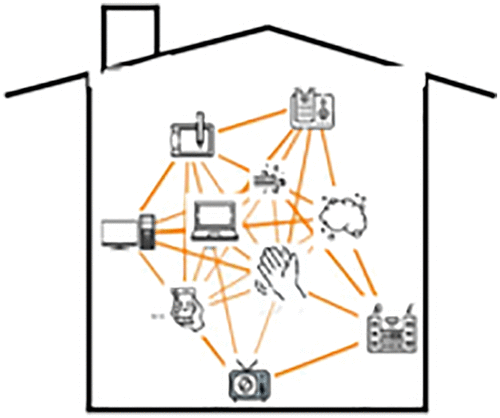当前位置:
X-MOL 学术
›
Environ. Sci. Technol. Lett.
›
论文详情
Our official English website, www.x-mol.net, welcomes your
feedback! (Note: you will need to create a separate account there.)
Hands as Agents of Chemical Transport in the Indoor Environment
Environmental Science & Technology Letters ( IF 8.9 ) Pub Date : 2021-03-23 , DOI: 10.1021/acs.estlett.0c01006 Miriam L. Diamond 1, 2, 3 , Joseph O. Okeme 4 , Lisa Melymuk 5
Environmental Science & Technology Letters ( IF 8.9 ) Pub Date : 2021-03-23 , DOI: 10.1021/acs.estlett.0c01006 Miriam L. Diamond 1, 2, 3 , Joseph O. Okeme 4 , Lisa Melymuk 5
Affiliation

|
Indoor environments are important sources of exposure to chemicals intentionally added to consumer products, building materials, etc. Previous work has shown that semivolatile organic compounds (SVOCs) migrate from product/material sources to partition to indoor surfaces, including skin and hands, and that SVOCs on hands reasonably indicate nondietary exposure to indoor SVOCs. We hypothesize that the hands of indoor occupants, which contact numerous products and surfaces, transport SVOCs in the indoor environment to an extent comparable to that of fugacity-driven and advective transport. This process of “hand-based” chemical transport is analogous to that of fomite transmission of pathogens. We explore this hypothesis using a data set of halogenated flame retardants, organophosphate esters, and phthalate esters in indoor air, floor dust, and wipes of hands and surfaces of electronic devices of 51 participants. Cluster analysis shows the similarity of the SVOC profiles on all participants’ hands relative to those of all device surfaces, demonstrating the ubiquity of these SVOCs. Network analysis consistently shows the centrality of hands, followed by air, dust, and laptops, indicating that hands are most correlated with all sample types. The significance of this hypothesis lies in the ability of hands to rapidly transfer SVOCs among surfaces indoors, with implications for exposure.
中文翻译:

在室内环境中充当化学运输的代理人
室内环境是有意暴露于有意添加到消费品,建筑材料等中的化学物质的重要来源。先前的研究表明,半挥发性有机化合物(SVOC)从产品/物质来源迁移到分区到室内表面,包括皮肤和手,并且手上的SVOC合理地表明非饮食性暴露于室内SVOC。我们假设接触许多产品和表面的室内居住者的手在室内环境中运输SVOC的程度与散逸驱动和对流运输的程度相当。这种“基于手”的化学运输过程类似于病原体的毒气传播过程。我们使用室内空气,地板粉尘,以及51位参与者的电子设备的手和表面湿巾。聚类分析显示了所有参与者手上的SVOC配置文件相对于所有设备表面的SVOC配置文件的相似性,证明了这些SVOC的普遍性。网络分析始终显示出手的中心性,其次是空气,灰尘和笔记本电脑,这表明手与所有样本类型相关性最高。该假设的意义在于手在室内表面之间快速转移SVOC的能力,这可能会导致暴露。其次是空气,灰尘和笔记本电脑,这表明手与所有样品类型相关性最高。该假设的意义在于手在室内表面之间快速转移SVOC的能力,这可能会导致暴露。其次是空气,灰尘和笔记本电脑,这表明手与所有样品类型相关性最高。该假设的意义在于手在室内表面之间快速转移SVOC的能力,这可能会导致暴露。
更新日期:2021-04-13
中文翻译:

在室内环境中充当化学运输的代理人
室内环境是有意暴露于有意添加到消费品,建筑材料等中的化学物质的重要来源。先前的研究表明,半挥发性有机化合物(SVOC)从产品/物质来源迁移到分区到室内表面,包括皮肤和手,并且手上的SVOC合理地表明非饮食性暴露于室内SVOC。我们假设接触许多产品和表面的室内居住者的手在室内环境中运输SVOC的程度与散逸驱动和对流运输的程度相当。这种“基于手”的化学运输过程类似于病原体的毒气传播过程。我们使用室内空气,地板粉尘,以及51位参与者的电子设备的手和表面湿巾。聚类分析显示了所有参与者手上的SVOC配置文件相对于所有设备表面的SVOC配置文件的相似性,证明了这些SVOC的普遍性。网络分析始终显示出手的中心性,其次是空气,灰尘和笔记本电脑,这表明手与所有样本类型相关性最高。该假设的意义在于手在室内表面之间快速转移SVOC的能力,这可能会导致暴露。其次是空气,灰尘和笔记本电脑,这表明手与所有样品类型相关性最高。该假设的意义在于手在室内表面之间快速转移SVOC的能力,这可能会导致暴露。其次是空气,灰尘和笔记本电脑,这表明手与所有样品类型相关性最高。该假设的意义在于手在室内表面之间快速转移SVOC的能力,这可能会导致暴露。











































 京公网安备 11010802027423号
京公网安备 11010802027423号